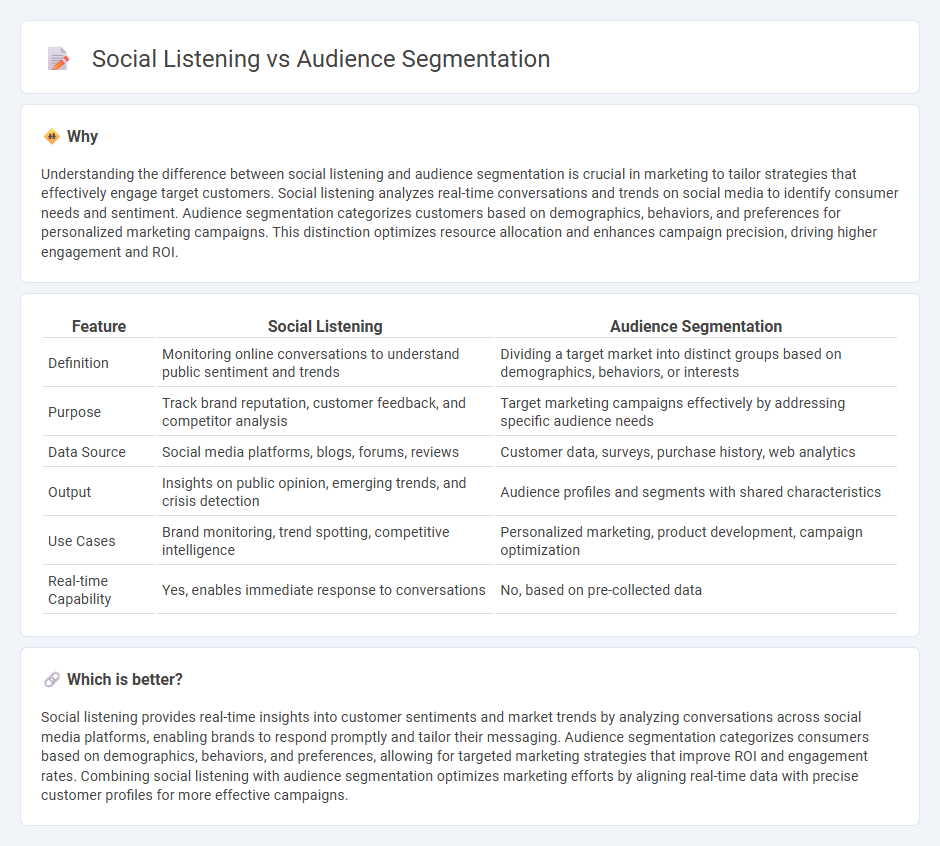
Social listening captures real-time conversations across social media, providing insights into customer sentiment and trending topics, while audience segmentation categorizes consumers based on demographics, behaviors, and preferences to tailor marketing strategies effectively. Combining these techniques enhances targeting precision and campaign relevance. Explore how integrating social listening with audience segmentation can transform your marketing outcomes.
Why it is important
Understanding the difference between social listening and audience segmentation is crucial in marketing to tailor strategies that effectively engage target customers. Social listening analyzes real-time conversations and trends on social media to identify consumer needs and sentiment. Audience segmentation categorizes customers based on demographics, behaviors, and preferences for personalized marketing campaigns. This distinction optimizes resource allocation and enhances campaign precision, driving higher engagement and ROI.
Comparison Table
| Feature | Social Listening | Audience Segmentation |
|---|---|---|
| Definition | Monitoring online conversations to understand public sentiment and trends | Dividing a target market into distinct groups based on demographics, behaviors, or interests |
| Purpose | Track brand reputation, customer feedback, and competitor analysis | Target marketing campaigns effectively by addressing specific audience needs |
| Data Source | Social media platforms, blogs, forums, reviews | Customer data, surveys, purchase history, web analytics |
| Output | Insights on public opinion, emerging trends, and crisis detection | Audience profiles and segments with shared characteristics |
| Use Cases | Brand monitoring, trend spotting, competitive intelligence | Personalized marketing, product development, campaign optimization |
| Real-time Capability | Yes, enables immediate response to conversations | No, based on pre-collected data |
Which is better?
Social listening provides real-time insights into customer sentiments and market trends by analyzing conversations across social media platforms, enabling brands to respond promptly and tailor their messaging. Audience segmentation categorizes consumers based on demographics, behaviors, and preferences, allowing for targeted marketing strategies that improve ROI and engagement rates. Combining social listening with audience segmentation optimizes marketing efforts by aligning real-time data with precise customer profiles for more effective campaigns.
Connection
Social listening gathers real-time data from social media platforms, revealing customer preferences and emerging trends. Audience segmentation uses this data to categorize consumers into distinct groups based on behavior, interests, and demographics. Integrating social listening with audience segmentation enhances targeted marketing strategies and improves personalized campaign effectiveness.
Key Terms
Audience Segmentation:
Audience segmentation involves dividing a broad target market into smaller, more defined groups based on demographic, psychographic, behavioral, or geographic criteria to tailor marketing strategies effectively. This method enhances personalization, improves customer engagement, and increases conversion rates by delivering relevant content to specific audience segments. Explore how audience segmentation can transform your marketing approach and drive measurable results.
Demographics
Audience segmentation categorizes individuals based on demographics such as age, gender, income, and location to tailor marketing strategies effectively. Social listening analyzes online conversations to uncover demographic patterns and trends, providing real-time insights into audience behavior and preferences. Explore how combining these approaches enhances targeted marketing campaigns.
Psychographics
Audience segmentation using psychographics involves categorizing consumers based on psychological traits such as values, attitudes, interests, and lifestyle, which helps brands tailor personalized marketing strategies. Social listening with a psychographic focus analyzes online conversations and sentiment to uncover consumer motivations, preferences, and emotional triggers in real-time. Explore how deeper psychographic insights from both methods can enhance your marketing effectiveness and customer engagement.
Source and External Links
What is Audience Segmentation? The 5 Main Types & Examples - Audience segmentation involves dividing a large audience into smaller, specific groups based on factors like demographics, behavior, psychographics, and more, enabling brands to tailor marketing effectively.
Audience Segmentation Guide: Types and Steps | Indeed.com - Audience segmentation categorizes customers into subgroups by shared needs or behaviors such as demographics or purchasing habits, helping optimize connection timing and methods.
How to Do Audience Segmentation - The Compass for SBC - Audience segmentation is a key part of audience analysis that groups people with similar values or needs to design effective behavior change communication strategies.
 dowidth.com
dowidth.com